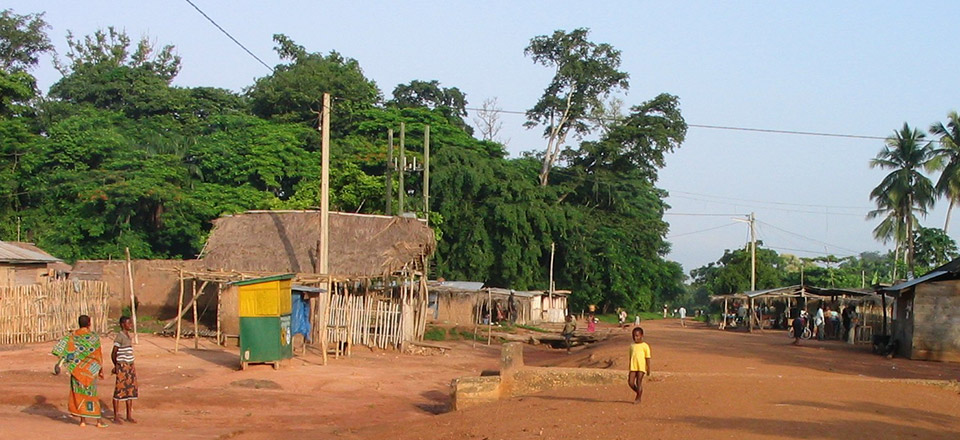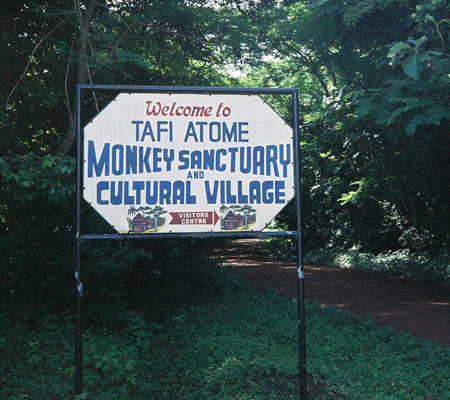Küla Tafi Atome on üle 1000 elanike ja asub Hohoe District of Volta Region Ghana. Elanikud räägivad ema keelt. Küla ümbritseb püha metsatukk umbes 28 on. Mets on poollehtmets ja asub metsa-savanni üleminekuvööndis. See on koheselt ümbritsetud rohumaa ja haritava põllumaaga. Salu sobitub IUCN kaitseala IV kategooria, elupaikade ja / või liikide juhtimise valdkonnas. Piirkond on kaitstud 2006 Hohoe District sundmäärus selle peamine väärtus on elupaigaks püha mona ahvid (Cercopithecus mona mona).
Vastavalt elanike, umbes 200 aastat tagasi, esivanemad elanikud Tafi Atome ala on öelnud, et on rännanud Assini Kesk Ghana Hohoe District. Nad tõid endaga iidol või kinnismõte, mis oli paigutatud püha metsa Tafi Atome, et hoida ohutu ja jahe. Mets oli kohe pühaks ja seega kaitstud. Veidi aega pärast nende piirkonda saabumist, külaelanikud hakkasid märkama ahve, keda nad arvasid olevat näinud oma algses Assini piirkonnas, ja uskus seetõttu, et ahvid olid neile järgnenud. Ahve peeti edaspidi "jumalate esindajateks", ja kaitstud kui püha.
1980ndatel, kohaliku Christian liider tõi vastandlikke arvamusi traditsiooniliste seadus, viinud halvenemist vaimne sidemed kinnismõte metsa ja erosiooni traditsioonilise kaitse. Residendid kärpima majanduslikult puud, eriti ümber hiis, kuni keskkonnaorganisatsioon aitas uuesti kinnitama kaitse salu 1990. Käib surve kohalikele elanikele selge metsade põllumaad ja langetada puid. Mona ahvide toitmiseks on ka turismisurve.
Ohustatud, Kohalikud elanikud avaldavad jätkuvat survet metsad põllumaaks raiuda.
Koalitsioon
Kogukond, sealhulgas turismikorralduskomitee, teeb koostööd organisatsioonidega, sealhulgas looduskaitseuuringute keskusega (NCRC) tegeleda turismiga, et säilitada püha metsasalu loodus- ja kultuuripärandit.
Tegevus
Sisse 1995, Accras asuv looduskaitseuuringute keskus külastas Tafi Atome küla ja leidis, et püha mets on lagunenud. Sisse 1996, alustati külas kogukonnapõhise ökoturismi projektiga. Sisse 1997, mahagonipuud istutati pühamu piiri piiritlemiseks, et peatada põllumaa edaspidine tungimine metsaserva.
1n 1998, ehitati turistide vastuvõtukeskus, mis oleks külasse saabuvate turistide esimene kontaktpunkt. Seda rahastasid kogukond ja välised annetajad.
Külaelanike arvamust hinnati küsitlustes vahemikus 2004 ja 2006.
Kaitse Tools
Nimetage kaitsevahendeid või lähenemisviise, mida on kasutatud või välja töötatud, et toetada tööd pühadel looduslikel aladel. Need võivad olla vahendid või meetodid, mida kasutatakse taimede ja loomade inventeerimiseks või jälgimiseks või kogukonna suutlikkuse arendamiseks ning paiga ja selle inimeste kultuuriväärtuste tugevdamiseks.. Mainida tuleks ka planeerimisvahendite ja juhiste kasutamist, näiteks IUCNi UNESCO pühade loodusalade juhised Wildi ja McLeodi kaitsealade haldajatele.
Kirjeldage kõige olulisemaid poliitikaid ja seadusi, mis toetavad või takistavad pühade looduslike paikade ja liikide säilitamist. Sisse 2006, Hohoe ringkond võttis vastu ametlikud põhimäärused, sealhulgas piirangud metsa pühamusse sisenemisel, puid kahjustada, taluda kaitsealal, või metsas loomi tappa.
Tulemused
Kogukonna liikmed, kes osalevad 2004 ja 2006 uuringute kohaselt on kogukonna kultuuriväärtused turismi edendamise tulemusena paranenud. Turistide tulek on toonud ka turismitulu, mis jaotatakse huvirühmade vahel (e.g. fetiši preester, pealikud) ja kasutatakse kogukonna arendamiseks, hüvitis pühapaiga maaomanikele, ja haridusfondid.
- Ormsby A ja Edelman, C. (2010) Kogukonnapõhiste Ökoturismi at Tafi Atome Monkey Sanctuary, püha looduspaik Ghanas , aastal Verschuuren B., Wild R., McNeely JA. ja Oviedo G. (eds) "Looduslike pühapaikade : Looduse ja kultuuri säilitamine” Earth Scan, London.
- Looduskaitseuuringute Keskus (NCRC), Ghana: Külasta Koduleht
- Ntiamoa-Baidu, Y. (1995) Põlisrahvad vs. Võttis kasutusele bioloogilise mitmekesisuse säilitamise strateegiad: Ghana kaitsealade süsteemide juhtum, Aafrika bioloogilise mitmekesisuse sari, 1, Bioloogilise mitmekesisuse toetusprogramm, Washington DC: Külasta Koduleht
- Ormsby, A. 2012. Arusaamad turismist Ghana ja India pühades metsades. RASAALA: Vaba aeg ja ühiskond Aafrikas, Aasia ja Ladina-Ameerika 3(1): 1-18.
- Ormsby, A. 2012. Ghana pühade metsade kultuurilised ja kaitseväärtused. p. 335-350 Pungettis, G., G. Oviedo ja D. Hooke (toim.) Sacred liikide ja kohtade: Edasiminek Biocultural Conservation. Cambridge: Cambridge University Press. Hankige väljaanne






